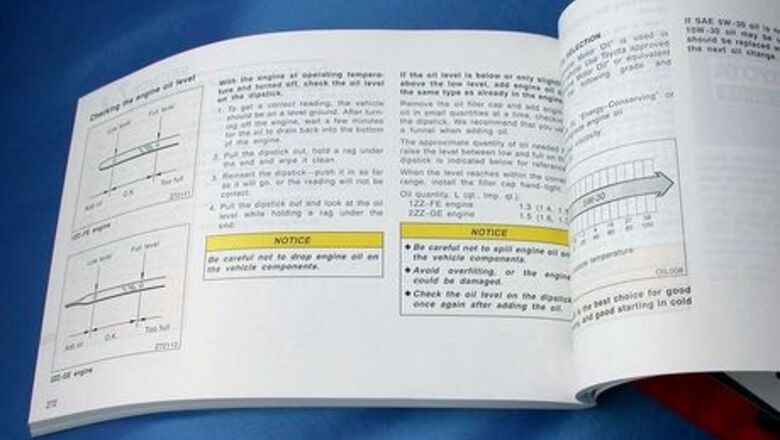
views
Handling the Job Safely and Responsibly
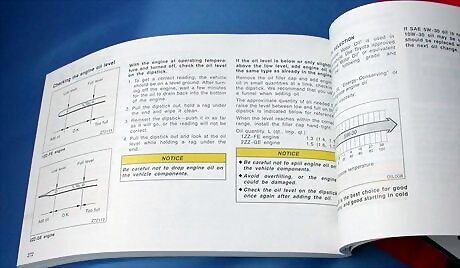
Make it a point to check the fluids in your vehicle roughly every 4-6 months. Your owner's manual will give you an idea of when you should take a peek at the fluid levels of each major component under the hood. However, this timeframe is usually the just minimum frequency needed to keep your warranty in effect. A better rule of thumb is to check your fluids about twice a year, or every 5,000-10,000 miles (whichever comes first). If you’re the forgetful type, it may be a good idea to mark your calendar or set a reminder on your device. Your car’s fluids are its lifeblood. Regular inspections will help you ensure that it has everything it needs to continue running cleanly and efficiently.
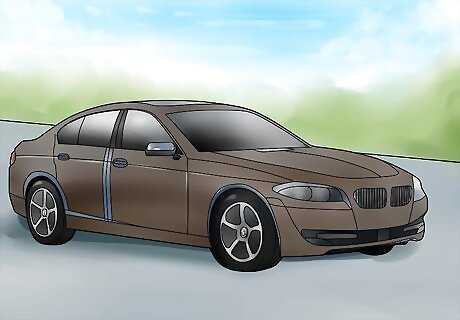
Park your car on a flat, level surface and set the parking brake. Pull the brake handle up as far as it will go to make sure that the braking mechanism is fully engaged. Setting the parking brake will prevent your vehicle from rolling or shifting unexpectedly while you’re messing around under the hood. If you have a button-style parking brake, simply push it in all the way to engage it. The safest place to check your car’s fluids is inside the garage or in a parking lot that isn’t too busy.
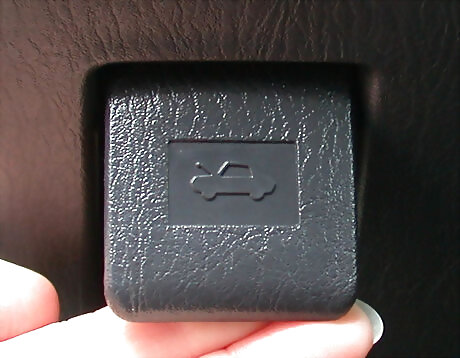
Pop your car’s hood to access your fluid reservoirs. Look around the console area for a small hand lever that controls the locking mechanism for the hood. This lever is usually located somewhere along the bottom part of the lefthand side of the dashboard and labelled with the symbol of a car with its hood up for easy identification. When you find it, pull it towards you. You’ll hear an audible click as the hood releases. With certain car models, it may be necessary to press a separate latch on the underside of the hood itself in order to open it up all the way. Use the thin metal rod situated to one side of the engine compartment to keep your hood propped up while you work.
Assessing Your Various Fluid Levels
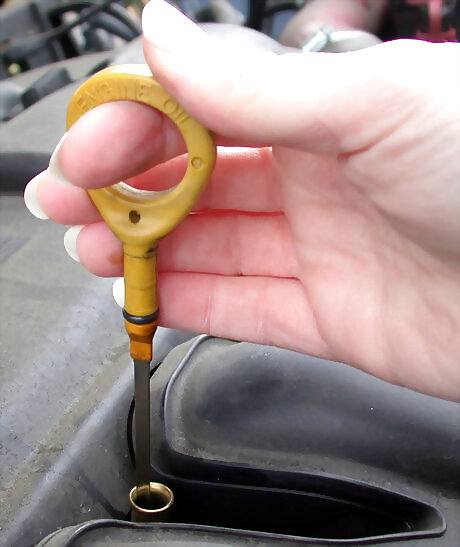
Start by checking your engine oil. Locate the yellow or white oil dipstick protruding from the top of the engine and hook your finger through the loop. Pull the dipstick all the way out, taking care to release any clips that might be holding it in place. Use a paper towel or rag to wipe the dipstick clean, then re-insert the dipstick into its opening and push it in as far as it will go. Pull the dipstick out again and observe the oil level. When you’re done, secure the dipstick back in its opening. Always check the oil after the car has had an hour or so to cool down. That way, the oil in the return galleries, cylinder head valleys, and other components will have a chance to drain, preventing false readings. The dipstick has markings on it indicating a range of acceptable oil levels (usually notched, dimpled, or scribed). Double check the markings you see against the diagrams in your owner's manual. If the oil level is too low, you’ll need to add an appropriate motor oil right away. Note the color of your oil, too. Clean engine oil is a translucent golden color. Dirty engine oil will typically be black or dark brown. If your oil looks dirty, review your car's records to see when the oil was last changed. A car can run on slightly darkened oil just fine, so it’s better to go by the schedule than the color alone. Schedule your oil changes based on time rather than mileage alone. Even if you don't drive the specified number of miles, it’s a good idea to replace your oil about once every six months, or more frequently if you do a lot of driving. It’s possible for your car’s oil to break down and become less effective even if it’s just sitting in the driveway. Repeated, dramatic loss of engine oil could be a symptom of a leak. Keep a close eye on the ground under the spot where you normally park to look for telling oil stains. If you notice any, get your car into a shop to have it looked at. If your oil appears milky or foamy, it could be contaminated with coolant. This could point to a blown head gasket or another serious issue.
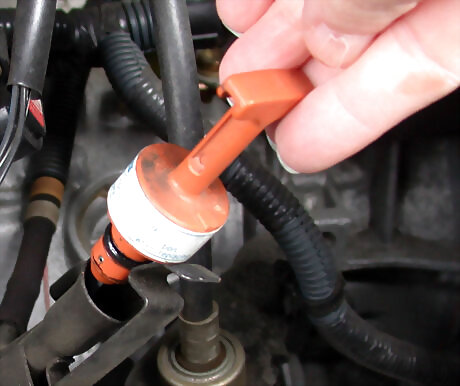
Take a look at your transmission fluid. For best results, do this while the engine is running and fully warmed up (either in neutral or park, depending on the make and model). It will be the second of two dipsticks on the engine, usually colored red. As you did with the oil dipstick, pull it out, wipe it off, push it all the way back in, then slide it out again and check the level. Once again, look for the fluid to fall between the two notches, grooves, or marks on the dipstick. Healthy transmission fluid will have glossy a reddish hue. If yours looks brown or black or has a distinct burnt odor, it’s probably time to replace it. Your transmission fluid doesn’t need to be changed anywhere near as often as your engine oil. In newer cars, the recommended service interval may be as high as 100,000 miles (160,000 km). Consult your owner’s manual to find more concrete guidelines for the model you drive. This fluid is responsible for lubricating the transmission, or your car's gear system. EXPERT TIP Hovig Manouchekian Hovig Manouchekian Auto Repair & Design Specialist Hovig Manouchekian is an Auto Repair and Design Specialist and the Manager of Funk Brothers Auto, a family-owned business operated since 1925. With over 30 years of experience in the automotive industry, Hovig specializes in the process of auto repair and maintenance. He is also very knowledgeable in common automotive issues and needs including engine repair, battery replacement, and windshield accessory and maintenance. Hovig's knowledge and hard work have contributed to Funk Brothers Auto winning Angie's List Super Service Award for five consecutive years. Hovig Manouchekian Hovig Manouchekian Auto Repair & Design Specialist If you have a coolant leak, find the source in the transmission. Temporarily bypass the cooler. If the leak stops, the issue is likely within the cooler or hoses. A persistent leak suggests a problem with the transmission itself. Seek a qualified mechanic for a diagnosis and repair to prevent further damage.
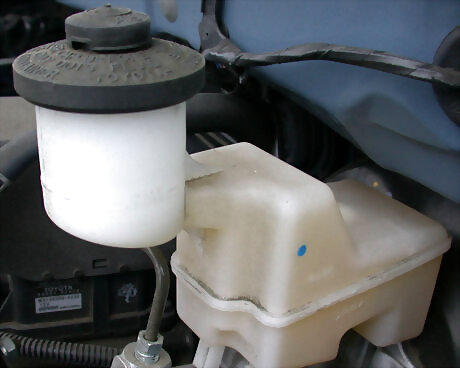
Inspect your brake fluid levels. Scan the engine compartment for a plastic reservoir labeled “brake fluid,” or flip through your owner’s manual to pinpoint its location. With most reservoirs, you’ll be able to read the fluid level right through the plastic. Wipe any dirt, dust, or debris off the outside of the tank, if necessary. If you still can't get a good look at the fluid, twist the cap off and peek inside. If your brake fluid reservoir is especially hard to see through, it may help to jostle your vehicle gently on its suspension to get the fluid sloshing around and create visible movement. Cars shouldn’t consume brake fluid, no matter how old or hard-driven they are. If your brake fluid looks low, have your car checked to find out why. The culprit may be a leak in the brake line or worn brake surface, which in the worst case scenario could cause your vehicle to fail to stop.
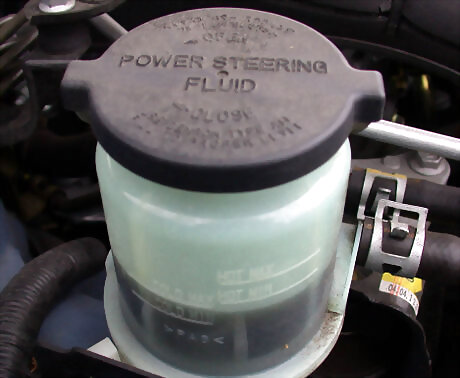
Eyeball your power steering fluid. This will also ordinarily be contained in a plastic reservoir close to the belts on the passenger side of the vehicle. Read the level through the walls the same way you did the brake fluid. In some cases, there may be two pairs of lines: one for a hot engine and one for a cold engine. Check the one that’s most appropriate for the state that your car is currently in. If you need to add more power steering fluid, you can do so by screwing the lid off the reservoir and pouring in an appropriate product up to the indicated fill line. These days, many cars are equipped with electronic power steering, which means they won’t have a fluid reservoir.
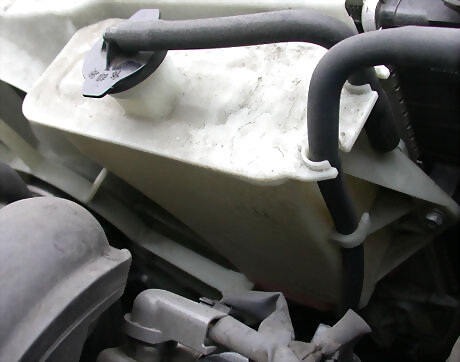
Evaluate your coolant levels. The coolant is housed in a reservoir at the front of the engine compartment near the radiator. This is another one that you can read right through the plastic tank. Ideally, your coolant should be clear and its original color. If it’s colorless, littered with small particles, or looks sludgy or gritty, it’s likely contaminated, in which case you’ll want to replace it ASAP. Never check your coolant levels without first allowing your engine to cool down completely. Opening the reservoir while it’s under pressure could cause scalding-hot water to come spraying out! Cars are designed to use antifreeze as coolant, not water. Antifreeze has a lower freezing point and a higher boiling point than water. If you need to replenish your coolant, make sure you’re using the right stuff. Be sure to read the label on the product you pick up. Some formulations can be added at full strength, while others must be mixed with an equal quantity of water. Sometimes there may be coolant in the reservoir but not in the radiator. If your reservoir is full but your car is running hot, remove the radiator hose to see if there’s enough fluid in the radiator.
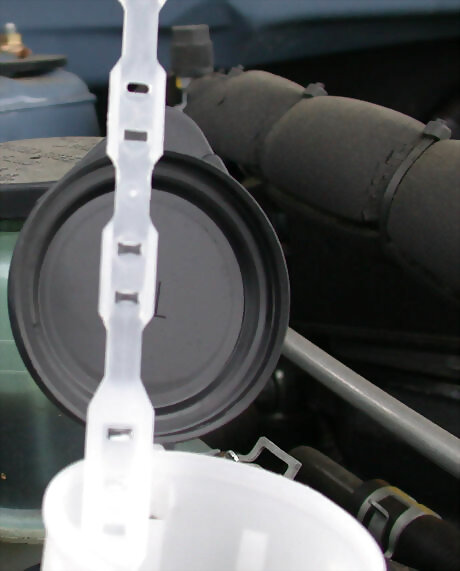
Top off your windshield wiper fluid if necessary. While low wiper fluid levels won’t affect the performance of your car, they will affect your visibility, safety, and overall driving experience. To see how much wiper fluid you’ve got in reserve, look for a brightly-colored container bearing the image of a windshield near the rear of the engine compartment. When you find it, lift the cap to check the contents. If needed, fill the container all the way to the top before pressing the cap back into place. Specialty wiper fluids formulated to easily cut through bugs and other road grime tend to be inexpensive, so there’s no excuse not to buy a quality product. However, adding a little water or window cleaner to the reservoir will also do the trick in a pinch. If you live somewhere with a cold climate, choose a type of fluid that won't freeze when temperatures drop. Wiper fluids with low freezing points will be plainly labelled as such.
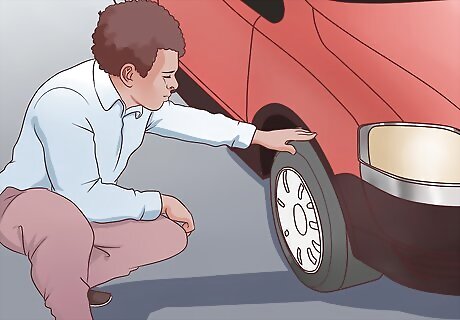
Make sure your tire pressure is satisfactory. This final check doesn’t involve fluids at all, but it’s still crucial for guaranteeing a smooth ride, improving your gas mileage, and increasing the overall safety of your vehicle. Twist the caps off of the small valve stems on each of your tires, press a tire pressure gauge into the stems firmly, and wait for the dial or stick to register a reading. Scan the sticker on the inside of your driver’s side door or read through the tire section of your owner’s manual if you’re not sure what number you’re looking for. As a general rule, you should check your tire pressure even more often than you do your key engine fluids. While you're down there, take a moment to appraise the tread on your tires. This will give you a better sense of where they are in their lifespan.

















Comments
0 comment